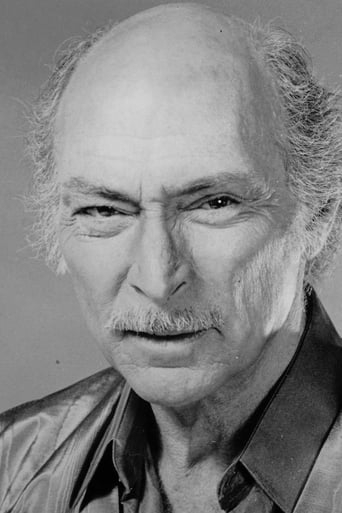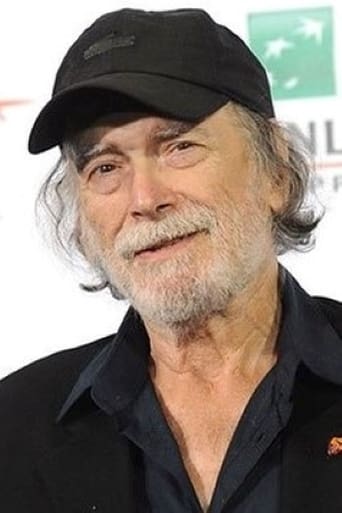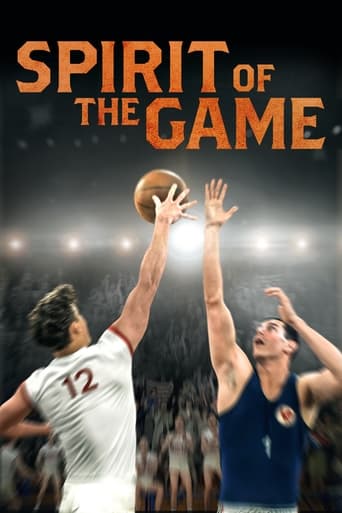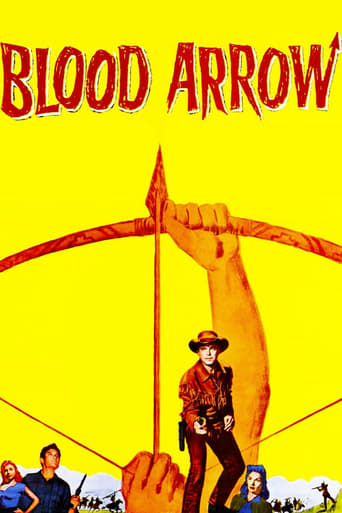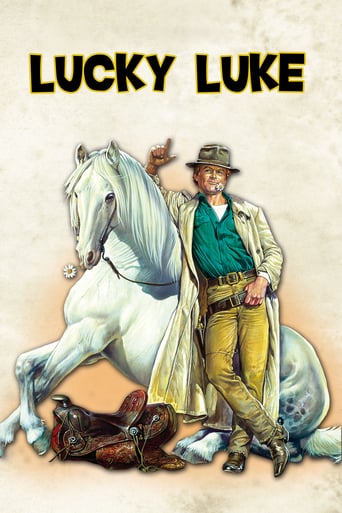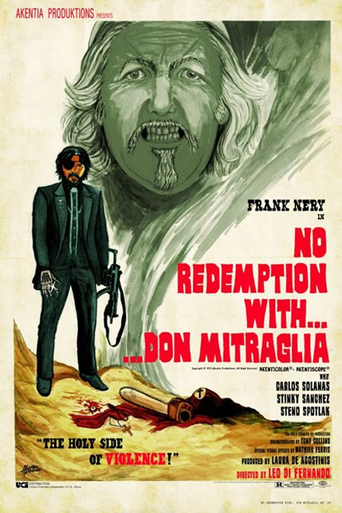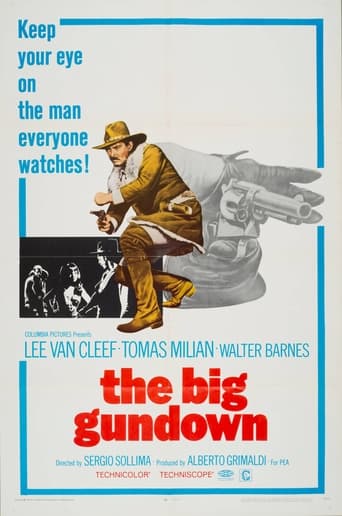

The Big Gundown (1967)
Unofficial lawman John Corbett hunts down Cuchillo Sanchez, a Mexican peasant accused of raping and killing a 12-year-old girl.
Watch Trailer
Cast


Similar titles
Reviews
Wow, this jaded viewer has finally been convinced that there's a spaghetti western out there to match Leone's in craft. The Big Gundown is a beautiful and florid movie that has a protean narrative, playing with sympathies, exploring sexuality and eroticism, being downrightly philosophical at times, and always fun.There's a scene in Robert Bresson's movie Lancelot du Lac, a movie where you mostly see big-headed though slightly vague and navel-gazing Arthurian knights, where one peasant prophesises to another that, "He whose footfalls precede him will die within a year." "Even if they're his horse's steps?" "Even then. he whose footsteps proceed him shall die within a year". It's a moment's contrast that illuminates the whole movie. Remarkable strange to see that sort of moment pop up in a spag. There's a scene where Corbett enters a bordello to question a prostitute, he barges into the place, and a ponchoed local moves to the side and around him, without anger, like one of these ephemeral shoal fish, flashing out of the way of a tuna. The next guy in the room looks at him with the same sort of understanding, in the manner of a person who treads softly. The meek shell inherit the earth.It's a film that's often boldly homoerotic, with guns very much positioned in as phallic a manner as possible, and a suggestive shot of three bullets superimposed on three men's groins. The "thorn" scene between Cuchilio and Corbett heightens this impression quite a bit and the men never seem quite at home with women.It has a similar sort of mythic feel to it that is often commented on with Leone. There's this weird predestination that sees protagonist and antagonist separate and meet up in the most unlikely of manners. It's one of the most surreal movies I've seen for a while, particularly the part where the bull wrangling takes place, eroticism incarnated, made all the more weird because it positively looks like the grass has been painted green.The only thing that I felt it lacked was a score that matched those of the second two "Dollars" movies. It was Morricone again, good, but not the same deal.
I listened to the theme song on YouTube numerous times and I already watched and enjoyed the sequel "Run, Man, Run"; so it was about time for me to watch the one and only "The Big Gundown". Everybody is always talking about the spaghetti westerns directed by Sergio Leone, and particularly the Dollar-trilogy, and even though I'm the very first person to admit his films truly are genius, there were so many over- talented Italian directors making great westerns around that same time and nobody ever mentions their work. Sergio Sollima's "The Big Gundown", for example, which came out during the same year as "The Good, the Bad and the Ugly" and even shares the same protagonist with Lee Van Cleef, is also a truly stellar and prime example of the spaghetti western genre. The film has a great cast, a stupendous Morricone soundtrack, an arousing plot outline, an intelligent script and numerous moments of great action & adrenalin, but apparently that's still not enough to qualify as an internationally acclaimed classic. Oh well, who cares, at least there's a handful of Italian cinema freaks out there (including Quentin Tarantino) that acknowledge and appreciate the smaller diamonds in the rough. I was fortunate enough to watch the fully uncut 107 minutes version, which features bits and pieces with original Italian sound edited into the American dubbed version. It's occasionally a bit peculiar to hear the sound switch and watch the colors fading, but the film makes much more sense with the cut bits into it. "The Big Gundown" has a very simple and rudimentary plot, but the elaboration is terrific and the chemistry between the two lead players – serious autonomous Lee Van Cleef and playful daredevil Tomas Milian – is sublime. Jonathan Corbett (Van Cleef) is a practically unbeatable Colorado lawman turned bounty hunter, and because of his prestige and honorable position, his friends are even suggesting him to run for congressman. Corbett then volunteers to bring Cuchillo Sanchez to justice; a Mexican immigrant and petty criminal who's now accused of raping and murdering a 12-year-old girl. Cuchillo is heading for Mexico and Corbett has to arrest him before he crosses the border. Cuchillo is a sly fox, however, and always manages to escape just in time. Meanwhile, Corbett increasingly grows uncertain whether he's even chasing the real culprit. "The Big Gundown" is literally full of memorable and notably brilliant sequences that are exemplary bits of great scriptwriting. Cuchillo's escape in the middle of the desert, for example, with just the help of a cactus and an innocent snake, is truly ingenious and clever. There are many more highlights in the film as well, like the escape from a ramshackle Mexican prison, the shootout between Van Cleef and a bunch of obnoxious simple-minded Texan cattle farmers and the virulent climax with not one but two duel showdowns! The soundtrack is legendary, with musical bits of Morricone genius like "The Verdict" and "The Surrender". The direction by Sergio Sollima – also responsible for the great "Violent City" and "Revolver" – is taut and professional, while Van Cleef and especially Milian deliver dazzling performances. This is Italian film-making at its finest.
1st watched 8/19/2007 - 7 out of 10(Dir-Sergio Sollima): Intriguing cat and mouse chase Italian-made western that keeps you guessing right up to the very end. Lee Van Cleef plays a cop that is doing his job by hunting down a Mexican who is accused of raping & murdering a 12-year old girl. As he catches and then loses this elusive fellow bits and pieces of the story begin to unravel that question the authenticity of the charge against him. We are brought along with the Lee Van Cleef character thru this interesting story that challenges our assumptions about who's right and who's wrong. To give any more away would ruin the movie for those who want to watch it, so I'll stop right there. The only real negative to this movie is the fact that it is dubbed and comes across a little corny at first, but once the story grabs you and the relationship between the two main characters becomes the central theme, you look over the mistake of not using subtitles and it doesn't bother you as much. Overall, this is a very well made spaghetti western that should be considered a classic in the genre.
At the 61st Venice Film Festival, Quentin Tarantino named THE BIG GUNDOWN not only his favorite Spaghetti Western but one of the all-time Top 5 Westerns!; ironically, though I knew of the film's reputation and had actually already missed out on it on late-night Italian TV due to a power cut, I was all set to give it another miss because I had intended to attend a screening of the latest film by nonagenarian Portuguese film-maker Manoel de Oliveira during which he was also to be presented with a Lifetime Achievement Award...but when, during a Press Conference, Tarantino singled out this one as being the film to see at the "Italian Kings Of The 'B'" retrospective (which he and Joe Dante were presiding over), I just had to be there - since, unlike most other titles at the Festival, it was reserved just that one screening! The show, then, was delayed by an unattended bag left inside the theater from the previous screening which, incidentally, had been Ferdinando Baldi's Spaghetti Western BLINDMAN (1972) and, given the paranoid state of affairs post-9/11, this necessitated the intervention of bomb disposal units/dogs/soldiers/police before anyone could be allowed to re-enter the hall and the projection of the next film could proceed! If that wasn't enough, Joe Dante - who was present at the screening and my brother and I could overhear him waxing lyrical to his wife about the film's qualities - had to leave the theater after the first few minutes of the projection because, for some reason, English subtitles were not supplied with the only available print! Anyway, let's get to the film itself: from the accompanying interview with director Sollima, I learned that the Tomas Milian role was originally intended for Gian Maria Volonte', who was to have played a much older "prey" - but then the characters' ages were reversed. As it turned out, this was the first film to feature Milian's "Cuchillo" Sanchez character - a wily Mexican peasant and a dexterous knife-thrower - which he reprised in RUN, MAN, RUN (1968; also directed by Sollima and whose R1 DVD courtesy of Blue Underground I ordered following this viewing, also because it's the only remaining title from the company's "The Spaghetti Western Collection" set I have yet to watch!). The original treatment (by Franco Solinas) was much more politicized but, even if this element was eventually toned down, it's still palpable in the film's critical depiction of the upper-classes - arrogant, duplicitous and perverse - vis-a'-vis the struggling and downtrodden but lusty (and, by extension, virile) lower classes.Lee Van Cleef has one of his best roles ever as renowned bounty hunter (with an eye on a place in the Senate) Jonathan Corbett; to me, his relationship with Milian's character is one of the strongest ever to be established within the entire Western genre, and it's this that elevates the film above most non-Leone Italian efforts. Ennio Morricone provides one of his most eclectic and haunting scores that's weird and exhilarating at the same time, especially towards the end of the film when the song (ironically called "Run, Man, Run" and with a heightened vocal rendition by Christy to match!) - which is also heard over the opening credits - is reprised. In contrast to the operatic and baroque styles adopted by the other two Sergios - Leone and Corbucci, respectively - Sollima utilizes a much more sober, humanist and, ultimately, realistic approach.The complexity of this film's script belies the general low esteem in which the genre is held (being episodic in nature, with Van Cleef and Milian meeting up with a plethora of diverse characters during the course of the manhunt; one of the most memorable scenes is when Van Cleef goes to look for Milian's wife, a feisty prostitute who verbally abuses her husband for having deserted her but then lashes out at Van Cleef when realizing his true intent, after which the latter is cornered by the entire local community!); indeed, at the time, these films were more authentic than the examples - the Western was then on its last legs - churned out by Hollywood...at least until THE WILD BUNCH (1969) came along! I remember when the film was reviewed in a journal available outside the venue of the Venice Film Festival, it was described as having allegiances with the giallo genre - Milian is accused of being a serial rapist - but, having rewatched the film, this element isn't sufficiently stressed to make that connection! One of its more interesting aspects, however, is the reciprocated respect that passes between Van Cleef and Austrian bodyguard/ex-military officer/aristocrat/marksman Gerard Herter (whose character Sollima admitted to having based on Erich von Stroheim). This, in turn, gives way to a terrific extended climax: first, we see Milian duel with the real culprit of the crimes he's suspected of, then Van Cleef's stand-off with the Baron, and finally the confrontation between Corbett and the villainous railroad tycoon who appointed him to trail Milian in the first place. The cast also features a brief but striking turn by Nieves Navarro as a nymphomaniac rancher(!) and Fernando Sancho as a Mexican policeman who, hating the revolutionaries as much as the Americans, is content to let them cut each others' throat.I'm surprised, therefore, that the film has still to make it to R1 DVD but I'm glad I picked up the R2 edition: the remastered print is beautiful and the film contains a 15-minute interview (though the video proved problematic initially) with Sergio Sollima that was highly engaging, informative and even funny (his quips about the highbrow Italian films of the time, the critics' darlings as opposed to the largely neglected genre offerings, is priceless!); in fact, I wish he'd done a full-length Audio Commentary for the film, as I really could have listened to him talk all day!!


